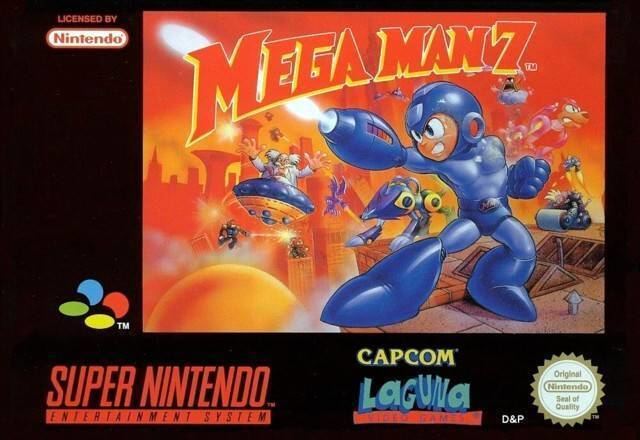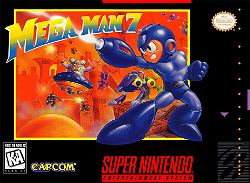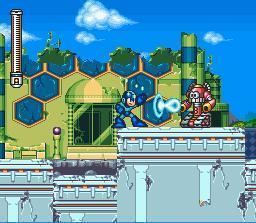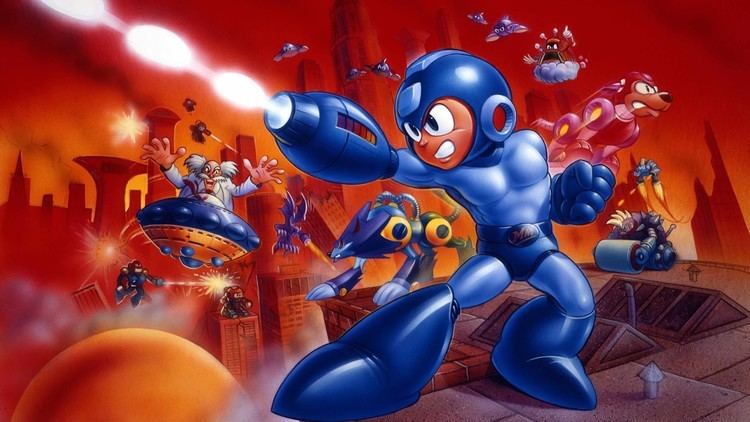9.4 /10 1 Votes9.4
Distributor(s) Marubeni | 4.7/5 Emuparadise Director(s) Yoshihisa Tsuda Initial release date 24 March 1995 Designer Tokuro Fujiwara | |||||||||||||||||||||||||||||||||
Programmer(s) Shinya IkutaKeiji Kubori Artist(s) Keiji InafuneHayato KajiToshifumi ŌnishiKazunori TazakiTatsuya Yoshikawa Composer(s) Yuko TakeharaToshihiko HoriyamaMakoto Tomozawa Similar Mega Man games, Capcom games, Platform games | ||||||||||||||||||||||||||||||||||
Snes longplay 054 mega man 7
Mega Man 7, known as Rockman 7: Shukumei no Taiketsu! (Japanese: ロックマン7 宿命の対決!, Hepburn: Rokkuman Sebun Shukumei no Taiketsu!, lit. "Rockman 7: Showdown of Destiny!") in Japan, is a action-platform video game developed by Capcom for the Super Nintendo Entertainment System. It is the seventh game in the original Mega Man series and the first and only title in the main series to be featured on the 16-bit console. The video game was first released in Japan on March 24, 1995 and was localized later in the year in North America and Europe. The game is also available for the PlayStation 2, Nintendo GameCube, and Xbox as part of the Mega Man Anniversary Collection.
Contents
- Snes longplay 054 mega man 7
- Mega man 7 this game rocks man part 1 game grumps
- Plot
- Gameplay
- Development
- Reception and legacy
- References

Picking up directly after the events of Mega Man 6, the plot involves the protagonist Mega Man once again attempting to stop the evil Dr. Wily, who uses a new set of Robot Masters to free himself from captivity and begin wreaking havoc on the world. Along with some help from his old friends, Mega Man finds potential allies in the mysterious robot pair Bass and Treble, who are later revealed to be in league with Wily. In terms of gameplay, Mega Man 7 follows that same classic action and platforming introduced in the 8-bit Nintendo Entertainment System (NES) titles, but updates the graphics and sound of the series for the more powerful SNES.

According to its creators, Mega Man 7 was only in development for a short time before its release. Keiji Inafune, a noted character designer and illustrator for the franchise, handed off his duties to Hayato Kaji for this installment. Mega Man 7 has received an overall average critical reception. Although many considered it a competent game by itself, a majority of reviewers either called it a simple rehash of previous entries in the Mega Man saga, or considered it inferior to Mega Man X, released on the SNES over a year earlier.

Mega man 7 this game rocks man part 1 game grumps
Plot

Taking place in the 21st century (the ambiguous year 20XX), Mega Man 7 begins directly after the events of Mega Man 6. Thanks to the efforts of Mega Man and his friends, Dr. Wily was finally brought to justice. However, Wily had always known that he might be imprisoned one day, and so he had constructed four backup Robot Masters in a hidden laboratory: Burst Man, Cloud Man, Junk Man, and Freeze Man. If they did not receive any communication for six months, they would activate and begin searching for their master. After six months, the robots activate, round up an army, and go on a rampage throughout the city in which Dr. Wily is being held. Mega Man is called into action. Upon driving into the city with Roll and Auto, he sees that it is in ruins, and that he is too late to stop Wily's Robot Masters from liberating the evil scientist. Mega Man gives chase, but is stopped by Bass, a robot with capabilities much like Mega Man's own, and his robotic wolf Treble. After a brief skirmish, Mega Man is informed that the two of them are battling Wily as well. Bass and Treble then take off, leaving Mega Man confused, but convinced that he has new allies and determined to again stop Dr. Wily's plans.

After Wily's Robot Masters are defeated, he dispatches four more to combat the protagonist: Spring Man, Slash Man, Shade Man, and Turbo Man. In one of the locations, Mega Man encounters an injured Bass and sends him to Dr. Light's lab for repairs. Mega Man defeats the remaining Robot Masters and goes back home, learning upon arriving that Bass had gone berserk and had torn up the lab, escaping with parts for new enhancements Dr. Light was working on. Wily appears on the video monitor and reveals that Bass and Treble are actually his own creations, and that they only gained his trust in order to steal the parts. Bass' apparent ambition is to best Mega Man in combat and prove himself as the strongest robot in existence. Mega Man makes his way to Wily's fortress and defeats Bass and Treble, and then Dr. Wily himself. As usual, Wily begs for mercy, but after giving him six chances to change his ways, Mega Man chooses to finish off the mad doctor for good, and threatens him with his Mega Buster. Terrified, Wily explains that as a robot, Mega Man is prevented from harming humans; Mega Man counters that he is "more than a robot". (In the Japanese version, Mega Man stands in silence.) Before Mega Man could do anything, he is interrupted when the fortress begins to self-destruct, and Bass and Treble arrive to rescue their creator at the last moment. Before escaping, Bass taunts Mega Man for his hesitation ("He who hesitates is lost"), vowing that he, Wily, and Treble will return to get their revenge. Mega Man then escapes the collapsing castle, contemplating the events that transpired, and returns home to his family.
Gameplay
Gameplay in Mega Man 7 is mostly identical to the six previous games in the series. The player, as Mega Man, must complete a series of side-scrolling platform levels that typically end in a boss battle with a Robot Master. Destroying the Robot Master earns the player its special Master Weapon, which can be selected and used in all future stages. Each Robot Master is weak to a specific Master Weapon. Unlike the first six Mega Man games, only four new Robot Master stages are selectable at a time. After the player completes the introductory level, the first four Robot Masters in the list (Freeze Man, Cloud Man, Burst Man, and Junk Man) are selectable. After these are beaten, the player is taken to the intermission Robot Museum stage. When this stage is beaten, the other four Robot Masters (Slash Man, Spring Man, Shade Man, and Turbo Man) become available.
Mega Man 7 uses many of the same conventions introduced in previous installments, such as sliding along the ground, being able to charge the Mega Buster for more powerful shots, and calling on the hero's dog Rush to perform various tasks. One unique feature is Rush Search, which causes Rush to dig up useful items wherever the player is standing. Certain stages contain the letters "R-U-S-H", which, when collected, will grant the player access to the "Rush Super Adaptor", a combination of the two enhancements introduced in Mega Man 6 with a powerful rocket-arm attack and jetpack for flying short distances. Defeated enemies found throughout each stage can give the player extra lives, items which refill health and weapon power, and special bolts. The player can visit "Eddie's Cybernetic Support Shop" from the stage select screen, which is run by Dr. Light's new lab assistant, Auto, and where these bolts can be spent on items and power-ups, a feature that originally debuted in the Game Boy Mega Man titles. The use of bolts and the purchase of items at a part shop would become a standard for the core titles starting with Mega Man 7. Other gameplay elements also exist, such as the player being able to obtain the robotic, helper bird Beat and Proto Man's trademark shield.
Development
Prior to the release of Mega Man 7, numbered entries in the original Mega Man series were only on the NES. Mega Man 7 is the first and only numbered title in the original series released on the SNES. Capcom had begun its Mega Man X spin-off series on the console more than a year before. Due to "bad timing", the development team had to work under a very tight, three month schedule to complete Mega Man 7. The franchise's primary artist Keiji Inafune, credited as "Inafking", felt that due to the team's high motivation during that time, it was a very fun experience for him personally. The new head illustrator Hayato Kaji, credited as "H.K", concurred, stating that the team was very devoted to the project's completion despite having to rush its development. Designer Yoshihisa Tsuda, credited as "Hisayoshi", recounted, "I remember it being quite fun, like a sports team camp or something. Still, there are so many things about this title that I have regrets about, and even at the time we all found ourselves wishing for another month or so to work on it." Inafune takes credit for designing the character Auto, who is based on stereotypical "tin man" robots he remembered seeing as a child. Inafune also did the initial rough sketches of Bass and Treble, which bear the names "Baroque" and "Crush" in his sketchbook. The ideas for these two characters were ultimately handed off to Kaji for design. As with many other games in the series, the eight Robot Masters featured in Mega Man 7 are the product of design contests held for fans by Capcom in Japan. Capcom received around 220,000 character submissions.
One of the development team's goals was to add locations where the Master Weapons can be used to interact with the environments of many stages. In addition, Inafune wanted to include a hidden boss battle mode and recommended the idea to Tsuda, who discussed the matter privately with the game's playtester. Just one week before the game went beta, the team decided to include this mode on the conditions that Mega Man and Bass be the only playable characters and that it would have no bugs. It was completed and included within two days. However, Capcom only made this mode accessible via a secret password. The team also intentionally made the game's final boss "insanely hard" and "something that cannot be defeated without the use of an Energy Tank". The beta for the original Japanese and overseas versions of Mega Man 7 occurred simultaneously. The translated localizations of the game contain less dialogue than their Japanese equivalent. When Mega Man gains a new weapon in the North American version, he speaks with Dr. Light; in the Japanese version, Mega Man may exchange banter with Roll or Auto as well as Dr. Light.
In summer 1994 Capcom announced that the game was finished but they had decided not to release it. According to Capcom, the resulting negative reaction from gamers was what prompted the game's eventual release. Gregory Ballard, the president of Capcom's North American division, admitted the company was too conservative in shipping copies of Mega Man 7 when it launched in the region during the fall of 1995. The demand for Capcom's released titles apparently did not meet the supply the previous year, causing the company to scale back during that particular release quarter.
The music and sound composition of Mega Man 7 was a collaboration of ten people, including Ippo Yamada, credited as "Ippo", who was pulled in to work on the game while he was working on another project. A CD soundtrack for Mega Man 7 containing 37 pieces of music was published for the first time in Japan by Team Entertainment on November 21, 2007 amidst the franchise's 20th anniversary. Three of Mega Man 7's composers, Yamada, Yuko Takehara, who was credited as "Yuk", and Makoto Tomozawa, credited as "V-Tomozoh", would later compose the soundtrack to Mega Man 10 along with composers from previous installments and Mega Man 8.
Reception and legacy
Critically, Mega Man 7 has received a consistently average reception in both past reviews and more contemporary retrospectives. A large amount of criticism arose from the game's alleged failure to bring anything new to an already aging series, with some considering it inferior to Mega Man X, which Capcom had released on the SNES more than a year prior. Tony Mott of Super Play found the game to lack improvement over its 8-bit counterparts in gameplay, stating that the level layouts are "muted and appear regular when compared to the X series". Brett Elston of GamesRadar similarly noted Mega Man 7 as feeling far too similar to the earlier games and that it pales in comparison to the SNES's more relevant and inventive Mega Man X. GamePro simply called it "a nice holdover" for fans waiting for the next game in the X series.
The game has enjoyed some positive remarks for its colorful presentation, play control, and challenge. GameSpot contributors Christian Nutt and Justin Speer praised it even compared to its predecessors: "Finally, a real upgrade to the original series on the SNES, after so many years on the moribund NES crippled the series. Unfortunately, it was a bit late to recover the massive popularity that the series had once enjoyed, but this was definitely a solid game." IGN's Levi Buchanan found the game to be one of the weaker installments in the franchise despite its attempt to add new gimmicks, some of which simply fall flat. "It's still worth a play to see the 16-bit jump," Buchanan summarized. "But expectations should be appropriately curtailed."
Lucas M. Thomas of IGN described the introduction of Mega Man's rival Bass as the seventh installment's most important contribution to the franchise. In spite of Mega Man 7 technologically moving the series from its NES roots to the next generation of consoles, it would eventually transition back to an NES visual and audio style similar to the first six titles many years later. Mega Man 7 has been officially re-released four separate times since its 1995 debut: first on the Nintendo Power Super Famicom cartridge service in Japan, second on the Mega Man Anniversary Collection in North America for the PlayStation 2 and GameCube in 2004 and the Xbox in 2005, third for the Wii U Virtual Console in 2014, and fourth for the New Nintendo 3DS Virtual Console in 2016.
Elements of the game made their way into Archie Comics' Mega Man line, though it never reached a full adaptation of the game prior to going on hiatus. However, Bass and Treble made a number of appearances, particularly in the series' humor strips, often to complain about wanting to be in the main series. Bass also appeared during the time travel story of issue 20, and later both appeared in Dr. Light's visions of the future in issue 55.
